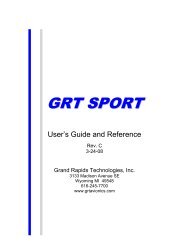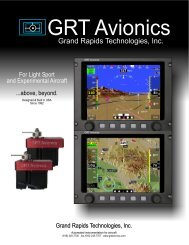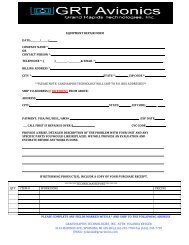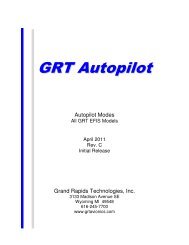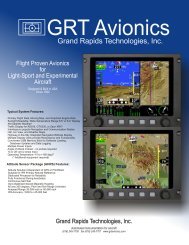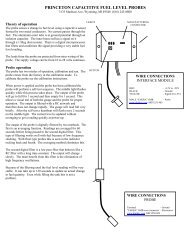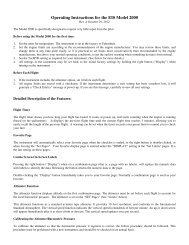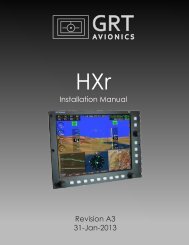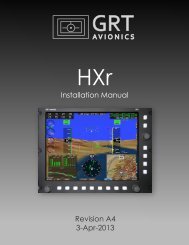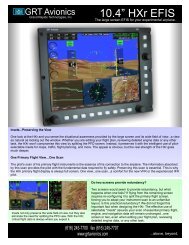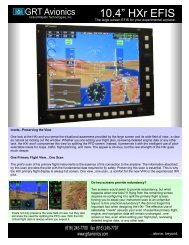Resistive Float Fuel Senders EIS
Resistive Float Fuel Senders EIS
Resistive Float Fuel Senders EIS
You also want an ePaper? Increase the reach of your titles
YUMPU automatically turns print PDFs into web optimized ePapers that Google loves.
Calibrating <strong>Resistive</strong> <strong>Float</strong>-Type <strong>Fuel</strong> <strong>Senders</strong><br />
<strong>EIS</strong> and Sport EFIS Manual Supplement<br />
Revision A1<br />
07-Aug-2013
Calibration of <strong>Float</strong>-Type <strong>Resistive</strong> <strong>Fuel</strong> <strong>Senders</strong> for <strong>EIS</strong> & Sport<br />
GRT Avionics<br />
Supplement Revision Notes<br />
Revision Date Change Description<br />
A 28-Jun-2013 Initial Release<br />
A1 07-Aug-2013 Corrected formula in Worksheet 2, Step 5 (scale factor calculation)<br />
2 Revision A1
Calibration of <strong>Float</strong>-Type <strong>Resistive</strong> <strong>Fuel</strong> <strong>Senders</strong> for <strong>EIS</strong> & Sport<br />
GRT Avionics<br />
Table of Contents<br />
Section 1: Introduction<br />
1.1 About <strong>Float</strong>-Type <strong>Resistive</strong> <strong>Fuel</strong> <strong>Senders</strong>………………………………………………………………….. 4<br />
1.2 Data Port and Hardware Requirements……………………………………………………………………. 4<br />
Section 2: Installation & Wiring Using the <strong>EIS</strong><br />
2.1 Mechanical Installation……………………………………………………………………………………………. 6<br />
2.2 Assigning Aux Inputs in <strong>EIS</strong>………………………………………………………………………………………. 6<br />
2.3 Wiring <strong>EIS</strong> and <strong>Senders</strong>…………………………………………………………………………………………….. 7<br />
2.4 Sport EFIS <strong>Fuel</strong> Sender Calibration Options………………….…………………………………………. 7<br />
Section 3: <strong>EIS</strong> Setup & Programming<br />
3.1 Set Up <strong>EIS</strong> Auxiliaries…………..……………………………………………………………………………………. 8<br />
3.2 Calibrate <strong>Fuel</strong> <strong>Senders</strong> and <strong>EIS</strong>….….…………….……………………………………………………………. 9<br />
Section 4: Set Up EFIS <strong>Fuel</strong> Gauge Display (<strong>EIS</strong> Aux Inputs)<br />
4.1 Configure EFIS <strong>Fuel</strong> Bar Graphs……….………………………………………………………………………. 11<br />
3 Revision A1
GRT Avionics<br />
Calibration of <strong>Float</strong>-Type <strong>Resistive</strong> <strong>Fuel</strong> <strong>Senders</strong> for <strong>EIS</strong> & Sport<br />
Section 1: Introduction<br />
1.1 About <strong>Resistive</strong> <strong>Float</strong> <strong>Senders</strong><br />
When aviation was new, fuel gauges consisted of a cork float connected to a wire shaped like an<br />
upside down L that ran up and out through a fuel cap visible to the pilot. The concept was simple:<br />
The cork floated on top of the fuel. As the fuel tank went from full to empty, the cork descended<br />
with the fuel level, causing the wire to slide down. When the upside down L rested on the cap, the<br />
cork was at its lowest, and tank was presumably empty.<br />
<strong>Resistive</strong> float senders are an electronic upgrade to this concept. The float is still there, but its rise<br />
or fall causes tiny changes in voltage which drive a fuel gauge instrument–In this case, an <strong>EIS</strong> or<br />
EFIS display.<br />
The gauge, in this case the <strong>EIS</strong> unit, measures the voltage that comes out of the sender unit. Voltage<br />
enters the sender unit from the <strong>EIS</strong> as an “excitation” current. It passes through a resistor that cuts<br />
the voltage down to a consistent, known voltage level. As the float moves up and down along a<br />
slide contact, the electrical current flows through a variable resistor that further changes the voltage.<br />
The <strong>EIS</strong> then reads the voltage levels flowing from the senders. The sender and <strong>EIS</strong> must be<br />
calibrated so that the float position voltage readings can be converted into pilot-friendly readings<br />
of gallons or liters.<br />
1.2 Data Port and Hardware Requirements<br />
<strong>EIS</strong> Data Port<br />
Power Connections<br />
Hardware Required<br />
Requires (1) AUX function per fuel tank sender.*<br />
Power is provided from the <strong>EIS</strong> unit.<br />
(1) float sender per fuel tank<br />
(1) 470 ohm (¼-½ watt) resistor per sender; available from GRT,<br />
Radio Shack or other electronics supply source<br />
*NOTE: <strong>EIS</strong> Model 2000 units have two user-definable Aux inputs. <strong>EIS</strong> Model 4000/6000/9000<br />
units have 6 user-definable Aux inputs. Any of these can be used for fuel senders.<br />
Revision A1 4
Calibration of <strong>Float</strong>-Type <strong>Resistive</strong> <strong>Fuel</strong> <strong>Senders</strong> for <strong>EIS</strong> & Sport<br />
GRT Avionics<br />
<strong>Fuel</strong> Tank<br />
Variable Resistor<br />
<strong>Float</strong><br />
How Does It Work?<br />
The Variable Resistor and float stem are wired to<br />
send a signal to the fuel gauge in the form of a<br />
precise level of voltage that depends on the<br />
position of the float. As the float rises, the voltage<br />
of the signal changes. Most of the time, the signal<br />
voltage is the lowest when the tank is empty, and<br />
the highest when it is full. (Not always-sometimes<br />
the opposite is true. This is where the<br />
Forward/Reverse Sensing adjustment will come<br />
into play later in this process.)<br />
<strong>Float</strong><br />
Converting Voltage to Gauge Readings<br />
The voltage level created by the float position is<br />
sensed by the <strong>EIS</strong>. But we don’t care about voltage<br />
levels, we care about gallons (or litres) in the tank.<br />
This is where Scale Factor comes in. The voltage<br />
range is somewhere between 0 and 5. If the <strong>EIS</strong><br />
senses 1 volt, where is the float position? How<br />
many gallons does 1 volt represent? Scale factor<br />
converts raw voltage to a value we can use on the<br />
<strong>EIS</strong>. This is done by calibrating the system. Horizon<br />
EFIS users can take advantage of automatic<br />
calculations by the EFIS to simplify the calibration<br />
process.<br />
“FULL” in reality<br />
“FULL” on gauge<br />
<strong>Float</strong><br />
<strong>Float</strong> Sender Limitations<br />
Sometimes the float hits the top of the fuel tank<br />
before the tank is full. This causes the gauge to<br />
read FULL when the tank is not truly full. Airplanes<br />
with dihedral run into this problem often because<br />
there is much more fuel uphill from the float. The<br />
same is true when it reads empty. Usually there is<br />
a small amount of fuel that remains in the tank<br />
when the float is at its lowest position. Irregularlyshaped<br />
tanks provide unique calibration challenges<br />
because the relationship of quantity to float<br />
position is not linear- The tank may contain more<br />
or less fuel at certain float levels. That’s why it’s<br />
important to add fuel in many small increments<br />
while calibrating the fuel senders to get a more<br />
accurate picture of reality.<br />
5 Revision A1
Calibration of <strong>Float</strong>-Type <strong>Resistive</strong> <strong>Fuel</strong> <strong>Senders</strong> for <strong>EIS</strong> & Sport<br />
GRT Avionics<br />
Section 2: Installation & Wiring<br />
2.1 Mechanical Installation<br />
Every airplane is different, so mechanical installation of senders is not covered in this Supplement.<br />
Use the airplane kit and/or sender instructions to properly install each sender.<br />
2.2 Assigning Aux Inputs in the <strong>EIS</strong><br />
<strong>Fuel</strong> senders wired to the <strong>EIS</strong> utilize the Auxiliary (Aux) functions. These are user-configurable data<br />
ports that can be used for a wide variety of sensors. They are labeled AX1, AX2, etc. and are found<br />
on <strong>EIS</strong> pages 12 and 13. (We call them “Aux” functions but the <strong>EIS</strong> label skips the “u” to save space.)<br />
Start your installation by deciding which Auxiliary inputs you will use for your fuel senders. If you<br />
are planning to mount the <strong>EIS</strong> in view on the instrument panel, keep in mind the position of the<br />
auxiliary input functions on the various <strong>EIS</strong> “pages”. Referring to figure 1b in the <strong>EIS</strong> installation<br />
manual, you will note that Aux 1, 2, & 3 appear on page 12, and Aux 4, 5 and 6* appear on page<br />
13. It is advisable to wire the fuel senders to two Aux inputs that are on the same page. For example,<br />
Left Tank on Aux 1, Right Tank on Aux 2, and <strong>Fuel</strong> Flow on Aux 3.<br />
You may fill in the My System table below to record the Aux inputs and other information for each<br />
sender to aid in creating your wiring diagram or schematic for your airplane. Refer to Figure 5a,<br />
Connector A wiring diagram, in the <strong>EIS</strong> manual to find pin assignments and suggested wire colors.<br />
This will come in handy later on if it becomes necessary to troubleshoot.<br />
*Model 2000 units have only 2 Aux inputs. Model 4000/6000 units with software versions prior to<br />
xxx46 only have 4 Aux inputs unless otherwise noted on the <strong>EIS</strong> data tag.<br />
My System- <strong>Fuel</strong> Sender Wiring Information<br />
<strong>Fuel</strong> Tank <strong>EIS</strong> AX Input <strong>EIS</strong> Pin Wire Color Notes<br />
– – A25 Blue 4.8V Excitation Output<br />
6 Revision A1
Calibration of <strong>Float</strong>-Type <strong>Resistive</strong> <strong>Fuel</strong> <strong>Senders</strong> for <strong>EIS</strong> & Sport<br />
GRT Avionics<br />
2.3 Wiring the <strong>EIS</strong> and <strong>Senders</strong><br />
Follow the instructions presented in Section 5.2 of the <strong>EIS</strong> installation manual for wiring the <strong>EIS</strong><br />
and its components. Wire the senders to the <strong>EIS</strong> using standard aircraft wiring practices. The general<br />
schematic for float-type fuel senders looks like this. The black dots represent wire splices. Follow<br />
the instructions for the senders to ensure that they are properly grounded.<br />
AX2<br />
Sender 2<br />
<strong>EIS</strong><br />
4.8V Excitation<br />
470 ohm resistors<br />
AX1<br />
Sender 1<br />
2.4 Sport EFIS <strong>Fuel</strong> Sender Calibration Options<br />
The Sport EFIS does not have Analog inputs, so Sport users must wire the fuel senders to the <strong>EIS</strong><br />
Aux inputs. However, if you have a Sport, you do not have to calibrate the senders using the <strong>EIS</strong>.<br />
You have the option to send the raw voltage data from the sender over the <strong>EIS</strong>-EFIS serial<br />
connection, using internal EFIS calculations to calibrate the senders instead. This method will<br />
eliminate the math necessary for <strong>EIS</strong> calibration described in the next few pages. However, it will<br />
also keep the <strong>EIS</strong> Aux fuel quantity readouts in raw format, so it is mainly recommended for builders<br />
who have chosen to blind-mount their <strong>EIS</strong> behind the instrument panel.<br />
To calibrate your senders using the Sport: After wiring the senders as described in Section 2 of<br />
this manual, skip ahead to Section 3.2 of the<br />
for instructions on calibrating the fuel senders. Disregard Sections 3 and 4 of this<br />
manual.<br />
7 Revision A1
Calibration of <strong>Float</strong>-Type <strong>Resistive</strong> <strong>Fuel</strong> <strong>Senders</strong> for <strong>EIS</strong> & Sport<br />
GRT Avionics<br />
Section 3: <strong>EIS</strong> Setup & Programming<br />
3.1 Set Up <strong>EIS</strong> Auxiliaries for <strong>Fuel</strong> <strong>Senders</strong><br />
To access <strong>EIS</strong> configuration menu: Press and hold Center and Right buttons. The “Save Lean<br />
Point?” page will appear initially, but keep holding the buttons until they disappear and the first<br />
configuration page appears.<br />
1. Optional: Refer to Section 7.1.1 in the <strong>EIS</strong> manual to create custom labels for the fuel tank Aux<br />
inputs (such as LF for Left <strong>Fuel</strong>, RF for Right <strong>Fuel</strong>).<br />
2. Decide if you would like to display fuel with a resolution of 0.1 (decimal) or 1 (integer). We<br />
generally recommend a resolution of 1 for fuel tanks, however, some <strong>EIS</strong> 2000 Aux resolutions<br />
are preset to display decimals. See Section 7.1.6 of the <strong>EIS</strong> manual for instructions on how to set<br />
up the Aux resolutions.<br />
3. Choose one tank to begin. For our example, we will use Aux 1 as the Left Tank and Aux 2 as<br />
the Right Tank.<br />
4. Access the <strong>EIS</strong> configuration menu. Press NEXT until you see 1SF. This is the Scale Factor for Aux<br />
1, the left fuel tank in our example. Press UP key to set 1SF to 100.<br />
5. Press NEXT key until you see 1OFF. This is the Aux 1 offset. Set 1OFF to 0.<br />
6. Press NEXT key until you see +/- in the upper left corner of the <strong>EIS</strong> screen. This is the<br />
Forward/Reverse sensing we mentioned on Page 5 of this supplement. The symbols in the line<br />
represent all of the Aux functions, from 1-6, left to right. For now, set the first two symbols in the<br />
line to +. This means Aux 1 and Aux 2 are set to Forward sensing. (See Section 7.1.5 in the <strong>EIS</strong><br />
manual for more on this.)<br />
7. Press and hold the Center and Right keys on the <strong>EIS</strong> to roll quickly through the rest of the settings<br />
and exit the Configuration Pages. If the sender is wired correctly, Aux 1 should now read<br />
something other than zero, as the voltage from the sender is now being read by the <strong>EIS</strong>.<br />
8. Repeat Steps 4 and 5 above for the right tank, if applicable (Aux 2 in our example).<br />
8 Revision A1
GRT Avionics<br />
Calibration of <strong>Float</strong>-Type <strong>Resistive</strong> <strong>Fuel</strong> <strong>Senders</strong> for <strong>EIS</strong> & Sport<br />
3.2 Calibrate <strong>Fuel</strong> <strong>Senders</strong><br />
Preparation: Begin with empty fuel tanks. This operation is easiest to accomplish with a helper to<br />
watch the <strong>EIS</strong> readout. Have a fitting with a rubber hose handy for easy draining of fuel into an<br />
approved fuel container. (Most fuel tank sumps can be unscrewed and replaced with a fitting for<br />
easy draining.) Level the aircraft so that it sits on the ground at an angle close to a straight & level<br />
cruise flight attitude to provide the most accurate fuel level reading in flight.<br />
NOTE: Due to the limitations of float senders described in Section 1.1 of this manual, it is not<br />
recommended to use the tank capacity as the “FULL” indication. The <strong>EIS</strong> should read the actual<br />
fuel level at the upper range limit of the float sender. For example, in a 15 gallon tank, the float<br />
sender may reach its upper limit at 12 gallons. When more than 12 gallons are in the tank, the <strong>EIS</strong><br />
will display 12; however, the gauge will read more accurately below 12 gallons, where sharper<br />
accuracy is most desired.<br />
1. Fill a clean fuel can (5 gallons will work for most kitplanes) with a known quantity of fuel. Record<br />
this quantity in Worksheet 1. Empty the can into the first tank to be calibrated; in this example,<br />
we’ll use Aux 1, Left Tank. The fuel level at this stage must be enough to raise the float off the<br />
bottom stop.<br />
2. Notice the numbers displayed on the <strong>EIS</strong> Aux 1 reading. As the float rises, the number should<br />
increase in value. If it decreases in value as fuel quantity increases, repeat Step 6 in Section 3.1<br />
and set Aux 1 to Reverse Sensing.<br />
3. Anytime after the float begins to rise, drain the fuel from the tank, paying close attention to the<br />
point at which the <strong>EIS</strong> readout stops moving. This means the float is at the bottom of its range.<br />
Note the amount of fuel left in the tank at this point and write it in Worksheet 1. This will become<br />
your “reserve” fuel amount that is in the tank after the gauge reads zero.<br />
4. Write the lower-limit float sender value as shown on the <strong>EIS</strong> Aux 1 on Worksheet 2, Line 1.<br />
5. After the original “known quantity” is all back in the tank, add to it, preferably using a metered<br />
fuel pump or dispenser marked in one-gallon/liter increments. Slowly fill the tank until the <strong>EIS</strong><br />
Aux 1 readout stops changing. This is the upper limit of the float sender. Note the amount of fuel<br />
in the tank at this time and write it in Worksheet 2, Line 4. This quantity will be used as your FULL<br />
fuel gauge reading.<br />
6. Write the upper float sender value as shown on the <strong>EIS</strong> Aux 1 in Worksheet 2, Line 2.<br />
7. Keep filling the tank to capacity and note the quantity difference between the upper limit of the<br />
fuel sender and the actual full quantity. Record it in Worksheet 1. This value will be useful for<br />
flight planning and documenting the actual quantity of the tank.<br />
8. Use Worksheets 1-3 on the next page to determine Scale Factor and Offset values for Aux 1, then<br />
program these values into the <strong>EIS</strong>. The <strong>EIS</strong> should now show an accurate fuel quantity in gallons<br />
or liters. Repeat Steps 1-8 for the other fuel tank(s).<br />
Revision A1 9
Calibration of <strong>Float</strong>-Type <strong>Resistive</strong> <strong>Fuel</strong> <strong>Senders</strong> for <strong>EIS</strong> & Sport<br />
GRT Avionics<br />
Worksheet 1: General Notes<br />
Left<br />
Tank<br />
Center<br />
Tank<br />
Right<br />
Tank<br />
Known quantity of fuel in container<br />
<strong>Fuel</strong> qty remaining below lower float limit<br />
<strong>Fuel</strong> qty added after upper float limit<br />
Worksheet 2: Calculate Scale Factor (AuxSF)<br />
Left<br />
Tank<br />
Center<br />
Tank<br />
Right<br />
Tank<br />
1 <strong>EIS</strong> Empty Reading<br />
2 <strong>EIS</strong> Full Reading<br />
3 RANGE= (Line 2) - (Line 1)<br />
4 <strong>Fuel</strong> QTY (gal or L) at upper limit of float sender<br />
5 Divide Quantity by Range; (Line 4)÷(Line 3)<br />
6 AuxSF = (Line 5) x 100.<br />
Round to nearest whole number.<br />
Worksheet 3: Calculate Auxiliary Offset (AuxOff)<br />
Left<br />
Tank<br />
Center<br />
Tank<br />
Right<br />
Tank<br />
7 (Line 1) x (Line 5); Round to nearest whole number.<br />
Multiply this by 10 if the Aux resolution is 0.1<br />
(decimal reading instead of integer)<br />
8 (Line 7) x 2<br />
9 AuxOff = (Line 8) - 1<br />
Note: Must be an odd number.<br />
10 Revision A1
Calibration of <strong>Float</strong>-Type <strong>Resistive</strong> <strong>Fuel</strong> <strong>Senders</strong> for <strong>EIS</strong> & Sport<br />
GRT Avionics<br />
Section 4: Set Up EFIS <strong>Fuel</strong> Gauge Display (<strong>EIS</strong> Aux Inputs)<br />
4.1 Configure EFIS <strong>Fuel</strong> Bar Graphs<br />
The EFIS engine page is configurable for many instrument display options. In this step, you will<br />
program it to show fuel quantity for each tank on a bar graph. This bar graph will appear on the<br />
ENG page and on the PFD or Map “split screen” views. On the HXr, you can also program one of<br />
the PFD engine dials to show fuel quantity for one or all tanks.<br />
1. Go to the main menu of the Set Menu page. Scroll to and select Graphical Engine Display.<br />
2. Scroll down toward the middle of the page until you see Aux Functions. Select the Aux Function<br />
that corresponds with the <strong>EIS</strong> Aux input that is programmed for fuel quantity in one of the<br />
tanks. In this example, we are using <strong>EIS</strong> Aux 1 for the Left <strong>Fuel</strong> tank.<br />
Setting Value Notes<br />
Aux1 Function Left <strong>Fuel</strong> Choose Left, Center or Right <strong>Fuel</strong>. Must match <strong>EIS</strong> Aux input.<br />
Left <strong>Fuel</strong> Integer/Decimal<br />
Integer<br />
3. Repeat for the rest of the fuel tanks.<br />
Recommended for fuel quantity; decimal is an option, but<br />
integer gives a more stable fuel level reading.<br />
Left <strong>Fuel</strong> Graph Min Level 3 These values specify the range of the bar graphs. For best results,<br />
enter the fuel quantities indicated at the upper and lower limits<br />
Left <strong>Fuel</strong> Graph Max Level 12 of float travel- in this example, 3 and 12 gallons in a 15-gal tank.<br />
4. For more information and options for displaying fuel quantity on Sport or Horizon EFIS displays,<br />
please see Section 3 of the <strong>Resistive</strong> <strong>Float</strong> Sender Calibration Supplement for Horizon EFIS.<br />
11 Revision A1
Calibration of <strong>Float</strong>-Type <strong>Resistive</strong> <strong>Fuel</strong> <strong>Senders</strong> for <strong>EIS</strong> & Sport<br />
GRT Avionics<br />
Congratulations, you are done!<br />
12 Revision A1



